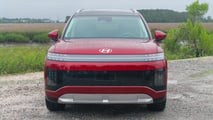
It’s official. Hyundai has done it again.
The South Korean automaker’s hot-selling Ioniq 5 crossover and ultra-long-range Ioniq 6 have earned it a reputation as an EV heavyweight. Now it’s defending its belt with the 2026 Ioniq 9, a head-turning three-row SUV with range for days, super-fast charging and crazy-good capacity for cargo and kids.
If you’re looking to haul a big family in style and under electric propulsion, the Ioniq 9 is about as good as it gets these days.
(Full disclosure: Hyundai covered my travel and lodging in Savannah, Georgia so I could test the Ioniq 9.)
2026 Hyundai Ioniq 9
Gallery: 2026 Hyundai Ioniq 9 First Drive Review







The 2026 Hyundai Ioniq 9: What Is It?
The roughly $60,000 Ioniq 9 is the latest salvo in a rapid-fire electric onslaught from the Hyundai Motor Group across its Hyundai, Genesis and Kia brands. It’s the biggest electric Hyundai yet and the company’s first battery-powered option for the booming three-row market.
The SUV rides on the Electric Global Modular Platform (E-GMP), the system of batteries, motors and electronics shared across all of the automaker’s latest and greatest EVs. Thank that E-GMP secret sauce for the Ioniq 9’s 300-plus-mile range across trims and blazing-fast charging capability.

Historically, large SUV buyers were limited to expensive or unconventional EVs like the Rivian R1S and Tesla Model X, and that meant a lot of them just stuck to gasoline. The Kia EV9 made a splash as effectively the first regular three-row EV that wasn’t just for rich people. Now the EV9’s Hyundai cousin introduces yet another attractive mainstream option—giving families a more realistic alternative to their trusty Toyota Highlanders and Hyundai Palisades.
What’s It Like To Drive?
The Ioniq 9 feels smooth and effortlessly powerful on the road, table stakes for any modern electric car. It’s also whisper-quiet inside, thanks to standard acoustic glass for the first and second rows plus active noise canceling—a first for a Hyundai. Ride quality is pleasant and controlled.

In its most powerful, dual-motor, all-wheel-drive guise, the Ioniq 9 isn’t rip-your-face-off quick like some other EVs. It’s a big, heavy boy after all. But it’ll blow away anybody who’s used to gas cars. And there’s more than enough power on tap for making quick highway passes and merges.
You can also tailor the experience to your liking through a handful of drive modes: Eco, Normal, Sport and Individual. As you toggle through the modes, the SUV’s estimated range rises and falls. That’s a nice touch, especially for EV newcomers.
Likewise, the regenerative braking system offers a high degree of customization via paddles behind the steering wheel. Between Level 0 (which feels like coasting in a gas car) and i-Pedal (which will aggressively bring the vehicle to a stop once you lift off the accelerator), there’s sure to be a setting in there for everyone. Like in previous E-GMP EVs, the regen-braking setting resets with every key cycle. So if you’re an i-Pedal lover, get ready to choose that every time.
The Ioniq 9 offers a nice Goldilocks driving position; it’s upright without being too tall and disconnected from the road. Visibility out of the front was great, thanks in part to that short hood. That’s all in contrast to, say, the gargantuan and boxy Cadillac Escalade EV I drove recently, which I could barely see out of.
I noticed a refreshingly solid view out the back, too. In a world where so many SUVs have pinched, sloping rears and no rearward visibility to speak of, the Ioniq 9 has a big, upright rear window that you can actually see something out of. What a thought.

Also aiding visibility: Blind-spot camera views that will be familiar to drivers of other Hyundai, Kia and Genesis vehicles. Upon signaling, a live camera feed of the relevant blind spot pops up right in the gauge cluster. I’ve said it before and I’ll say it again: I’m stumped as to why this isn’t in more new cars.
What’s nice is that a ton of safety and driver-assistance features come standard with the Ioniq 9. That includes blind-spot collision avoidance, rear cross-traffic avoidance, lane-keep assist and highway driving assist 2, Hyundai’s adaptive cruise control feature with automatic lane centering.
It’s A Head Turner
Design is subjective, but I think the Ioniq 9 knocks it out of the park. It has a high-end air about it and a striking presence. Its swept-back silhouette straddles the line between a minivan and an SUV in, I believe, a more successful way than the Lucid Gravity.

Some other highlights: A strip of square pixels—a signature design flourish found across the Ioniq lineup—make up the Ioniq 9’s daytime running lights. A similar upside-down U of pixels snakes around the rear hatch. The hood curves ever so seamlessly to meet the grille. Flush door handles give the Ioniq 9 a clean look.
And this isn’t all just for show. That streamlined shape also cuts the Ioniq 9’s drag and boosts range, Hyundai says.
Interior & Tech
The Ioniq 9 is also a pleasant place to spend time in. The top-trim, $76,590 Calligraphy SUV I drove featured supple leather-like surfaces everywhere, an attractive two-tone steering wheel, an interesting textured accent on the dash and a suede-like material on the ceiling. The whole cabin was solidly built and easy on the eyes.

Regardless of your chosen trim’s fanciness or options, you get a cabin that is both incredibly spacious and functional. Up front, I was impressed by the abundance of little shelves and cubbies to put things like sunglasses, phones, charging cables and snacks. My tester came with the “Universal Island 2.0,” a trick center console that slides forward and backward and can be opened from either the first or second row. There are high-powered 100-watt USB-C ports scattered throughout all three rows. Wireless charging pads are included, too.
Thanks to those stretched-out, minivan-like dimensions, the Ioniq 9 is exceptionally roomy and airy-feeling inside. Its 123-inch wheelbase is nine inches longer than that of the Palisade. Its wheelbase is also slightly longer than a standard gas Escalade’s, despite being over a foot shorter overall.

That means, among other things, that you can fit three six-foot-tall adults behind one another. I tried this out for myself and had gobs of headroom and legroom in the palatial second row. I could even fit decently comfortably in the third, though thigh support wasn’t great. The Ioniq 9 will offer both a six-seat option with second-row captain's chairs and a seven-seater with a bench instead.
The Ioniq 9’s floor is flat throughout, providing tons of room for both feet and cargo. The second and third rows fold flat, creating a cavernous area for that weekend camping trip or moving a kid into college. The SUV serves up 21.9 cubic feet of cargo capacity behind the third row, a few cubes more than a Palisade. There’s 46.7 cubic feet of room with the back seats folded and 86.4 cubic feet behind the first row.

The Ioniq 9 comes with dual, 12.3-inch displays that are nice to look at and easy to use. Even if the Ioniq 9 doesn’t serve up the kind of dazzling capability you get in a Tesla or a Rivian, there’s a lot to like here. You get wireless Apple CarPlay and Android Auto, route planning functions and, new for Hyundai, Amazon Music and SoundCloud. The central touchscreen is quick and snappy, and the whole system is elegantly curved toward the driver.
The climate controls are a mix of physical and digital controls. It’s nice that the temperature can be controlled via a knob that’s easy to feel around for. But a bunch of other functions are packed into a small touch-based panel. It looks sleek in theory, but in practice using those functions requires taking your eyes off the road momentarily, which I didn’t love.

How Good Is It As An EV? Very.
One thing that kept popping into my mind as I was driving the Ioniq 9: Is this a budget Lucid Gravity? In some ways, it is—it’s a spacious, van-like electric SUV with heaps of EV street cred. Of course, the Gravity offers a lot more range, space and performance, but it’s also a far pricier vehicle.
So, what do you get EV-wise in the Ioniq 9? A highly competitive 335 miles of range, for starters. Keep in mind that that rating only applies to the rear-wheel-drive variant, and that setup is only available on the base-trim SUV. So if you want the absolute best driving range, you’ll have to sacrifice some bells and whistles.

Still, a 110.3-kilowatt-hour battery pack provides at least 311 miles of range no matter which trim you choose. That’s very good. It's also beats the top-range RWD EV9 by seven miles and the entry-level one by 81 miles. (The EV9 has two battery options, both of which are smaller than the Ioniq 9's pack.)
Charging is equally impressive, and I’d expect no less given the performance of other cars on the 800-volt E-GMP platform. The Ioniq 9 can accept 237 kilowatts of charging power, allowing it to replenish its battery from 10%-80% in 24 minutes. That’s longer than the Ioniq 5, mainly because the Ioniq 9 has a bigger battery.
There are also a few ways in which the Ioniq 9 comes out of the gate as a better EV than the Hyundais that came before it.

The Ioniq 9 will have Plug & Charge capability at Tesla, Ionna and Chargepoint stations, meaning owners simply plug their car in and payment is taken care of automatically.
The SUV is also one of the first non-Tesla EVs to come with that automaker’s charging port design. That should allow for adapter-free charging at more than 17,000 Tesla Superchargers nationwide. And Hyundai will provide an adapter for use at non-Tesla stations. (The 2025 Ioniq 5 also has a Tesla port and Plug & Charge capability.)
The only issue is that Superchargers operate at around 400 volts, while the Ioniq 9 operates at 800 volts. The Ioniq 9 has to boost the voltage coming from the Supercharger for charging to work at all, so you won’t see those 237-kW speeds at Tesla stations. Until Tesla rolls out its higher-voltage V4 stalls, Supercharging will max out at 126 kW for the Ioniq 9. That means a significantly slower 10%-80% charge time of 40 minutes, per the automaker.

The Ioniq 9 is also the first Hyundai to offer true bidirectional charging capability. Other E-GMP cars have offered a feature called vehicle-to-load. This is essentially a household power outlet that lets you plug in things like a coffee maker or the like when on the go. And the Ioniq 9 has that too. But the SUV takes things a step further.
It can also serve as an automatic backup battery for one’s home, share power back to the grid in times of need and participate in managed charging programs through local utilities.
Early Verdict: A Much-Needed Addition
The problem with pretty much all EVs nowadays is that they’re too damn expensive. I can’t help but wonder if many Americans will bristle at the nearly $80,000 price of the Calligraphy model I sampled, no matter how premium the Ioniq 9 is or the glow-up that Hyundai has had in recent years.

Even the Ioniq 9’s starting price of $60,555 after destination fees is thousands of dollars more than a fully loaded Palisade. That alone will sideline a lot of eager buyers. I should note, however, that the SUV is built at Hyundai's giant new Metaplant in Georgia and qualifies for the $7,500 EV tax credit (as long as it exists). So that should help defray some of the cost. And Kia has seen a lot of success with the comparably priced EV9.
Plus, when you compare the Ioniq 9 apples-to-apples with other EVs, its price starts to make a lot more sense. There aren’t many full-size, three-row electric SUVs, and they’re all expensive.
The R1S starts at around $80,000. The new Volvo EX90 does too, commanding a more-than-$20,000 premium over the gas-powered XC90. The Gravity costs $95,000 and up right now. The Volkswagen ID. Buzz matches the Ioniq 9 on MSRP, but has about 100 miles less range.
The three-row SUV space is in dire need of more accessible electric options for families looking to lower their gas bills and try out the latest technology. The Ioniq 9 delivers just that—and looks to be another slam dunk from Hyundai Motor Company.
Contact the author: tim.levin@insideevs.com







